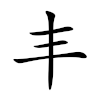丰
Jump to navigation
Jump to search
| ||||||||
Translingual
[edit]| Stroke order | |||
|---|---|---|---|

| |||
Exists as traditional character, but also Simplified from 豐 (elimination of 豈 and 丰).
| Traditional | 豐 |
|---|---|
| Shinjitai | 豊 |
| Simplified | 丰 |
Han character
[edit]丰 (Kangxi radical 2, 丨+3, 4 strokes, cangjie input 手十 (QJ), four-corner 50000, composition ⿻三丨(GJKV) or ⿻⿱㇒二丨(HT))
Derived characters
[edit]References
[edit]- Kangxi Dictionary: page 79, character 8
- Dai Kanwa Jiten: character 76
- Dae Jaweon: page 161, character 3
- Hanyu Da Zidian (first edition): volume 1, page 28, character 7
- Unihan data for U+4E30
Chinese
[edit]Glyph origin
[edit]| Historical forms of the character 丰 | |||
|---|---|---|---|
| Shang | Western Zhou | Shuowen Jiezi (compiled in Han) | Liushutong (compiled in Ming) |
| Oracle bone script | Bronze inscriptions | Small seal script | Transcribed ancient scripts |

|

|

|

|
|
References:
Mostly from Richard Sears' Chinese Etymology site (authorisation),
| |||
| Old Chinese | |
|---|---|
| 邦 | *proːŋ |
| 梆 | *proːŋ |
| 垹 | *proːŋ |
| 肨 | *pʰroːŋs, *pʰroːŋs |
| 蚌 | *broːŋʔ, *breːŋʔ |
| 玤 | *broːŋʔ |
| 棒 | *broːŋʔ |
| 蜯 | *broːŋʔ |
| 琫 | *poːŋʔ |
| 菶 | *poːŋʔ, *boːŋʔ |
| 俸 | *poːŋʔ, *boŋs |
| 髼 | *boːŋ |
| 蜂 | *boːŋ, *pʰoŋ |
| 韸 | *boːŋ |
| 蓬 | *boːŋ |
| 篷 | *boːŋ |
| 唪 | *boːŋʔ, *boŋʔ |
| 埲 | *boːŋʔ |
| 丰 | *pʰoŋ |
| 妦 | *pʰoŋ |
| 仹 | *pʰoŋ |
| 峯 | *pʰoŋ |
| 峰 | *pʰoŋ |
| 鋒 | *pʰoŋ |
| 烽 | *pʰoŋ |
| 蠭 | *pʰoŋ |
| 桻 | *pʰoŋ |
| 莑 | *pʰoŋ |
| 夆 | *pʰoŋ, *boŋ, *ɡaːds |
| 捧 | *pʰoŋʔ |
| 逢 | *boŋ |
| 縫 | *boŋ, *boŋs |
| 漨 | *boŋ |
| 捀 | *boŋ, *boŋs |
| 奉 | *boŋʔ |
Pictogram (象形) . The original version is 𡴀.
Etymology 1
[edit]| For pronunciation and definitions of 丰 – see 豐 (“luxuriant; lush; abundant; bountiful; plenty; etc.”). (This character is the simplified form of 豐). |
Notes:
|
Etymology 2
[edit]| trad. | 丰 | |
|---|---|---|
| simp. # | 丰 | |
| alternative forms | 𡴀 䒠 | |
Pronunciation
[edit]- Mandarin
- (Standard Chinese)+
- Hanyu Pinyin:
- Zhuyin: ㄈㄥ
- Tongyong Pinyin: fong
- Wade–Giles: fêng1
- Yale: fēng
- Gwoyeu Romatzyh: feng
- Palladius: фэн (fɛn)
- Sinological IPA (key): /fɤŋ⁵⁵/
- (Standard Chinese)+
- Cantonese
- (Standard Cantonese, Guangzhou–Hong Kong)
- Jyutping: fung1
- Yale: fūng
- Cantonese Pinyin: fung1
- Guangdong Romanization: fung1
- Sinological IPA (key): /fʊŋ⁵⁵/
- (Standard Cantonese, Guangzhou–Hong Kong)
- Middle Chinese: phjowng
- Old Chinese
- (Zhengzhang): /*pʰoŋ/
Definitions
[edit]丰
- having a lush growth of plants
- appearance
Compounds
[edit]Etymology 3
[edit]| For pronunciation and definitions of 丰 – see 丯. (This character is a variant form of 丯). |
References
[edit]Japanese
[edit]Kanji
[edit]丰
Readings
[edit]- Go-on: ふ (fu)、ぶ (bu)
- Kan-on: ほう (hō)、ふう (fū)
- Kan’yō-on: ぼう (bō)
- Kun: みめよい (mimeyoi, 丰い)、しげる (shigeru, 丰る)
Compounds
[edit]Korean
[edit]Hanja
[edit]丰 (eumhun 예쁠 봉 (yeppeul bong))
- This term needs a translation to English. Please help out and add a translation, then remove the text
{{rfdef}}.
References
[edit]Vietnamese
[edit]Han character
[edit]- This term needs a translation to English. Please help out and add a translation, then remove the text
{{rfdef}}.
Categories:
- CJK Unified Ideographs block
- Han script characters
- CJKV simplified characters
- CJKV characters simplified differently in Japan and China
- Translingual lemmas
- Translingual symbols
- Han pictograms
- Chinese lemmas
- Mandarin lemmas
- Cantonese lemmas
- Taishanese lemmas
- Hakka lemmas
- Eastern Min lemmas
- Hokkien lemmas
- Teochew lemmas
- Wu lemmas
- Middle Chinese lemmas
- Old Chinese lemmas
- Chinese hanzi
- Mandarin hanzi
- Cantonese hanzi
- Taishanese hanzi
- Hakka hanzi
- Eastern Min hanzi
- Hokkien hanzi
- Teochew hanzi
- Wu hanzi
- Middle Chinese hanzi
- Old Chinese hanzi
- Chinese adjectives
- Mandarin adjectives
- Cantonese adjectives
- Taishanese adjectives
- Hakka adjectives
- Eastern Min adjectives
- Hokkien adjectives
- Teochew adjectives
- Wu adjectives
- Middle Chinese adjectives
- Old Chinese adjectives
- Chinese nouns
- Mandarin nouns
- Cantonese nouns
- Taishanese nouns
- Hakka nouns
- Eastern Min nouns
- Hokkien nouns
- Teochew nouns
- Wu nouns
- Middle Chinese nouns
- Old Chinese nouns
- Chinese proper nouns
- Mandarin proper nouns
- Cantonese proper nouns
- Taishanese proper nouns
- Hakka proper nouns
- Eastern Min proper nouns
- Hokkien proper nouns
- Teochew proper nouns
- Wu proper nouns
- Middle Chinese proper nouns
- Old Chinese proper nouns
- Chinese terms spelled with 丰
- Chinese simplified forms
- Chinese terms with IPA pronunciation
- Chinese verbs
- Mandarin verbs
- Cantonese verbs
- Middle Chinese verbs
- Old Chinese verbs
- Chinese variant forms
- Japanese kanji
- Japanese hyōgai kanji
- Japanese kanji with goon reading ふ
- Japanese kanji with goon reading ぶ
- Japanese kanji with kan'on reading ほう
- Japanese kanji with kan'on reading ふう
- Japanese kanji with kan'yōon reading ぼう
- Japanese kanji with kun reading みめよ・い
- Japanese kanji with kun reading しげ・る
- Korean lemmas
- Korean hanja
- Vietnamese lemmas
- Vietnamese Han characters
- CJKV simplified characters which already existed as traditional characters



